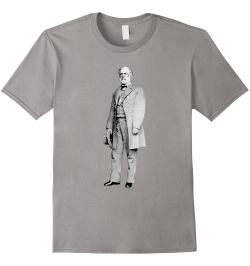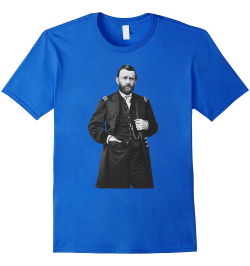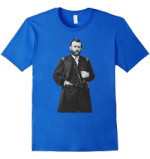Civil War Interview: Peter J. D'Onofrio
Today we are joined by Peter J. D'Onofrio, Civil War re-enactor and President of the Society of Civil War Surgeons. Peter is also the editor of The Journal of Civil War Medicine a quarterly journal published to the members of the Society (you can view a sample journal by clicking on the logo at the bottom of the page linked to above).
Peter has done extensive research on the medical service during the Civil War, and he shares some of his knowledge in this interview. Please enjoy!
1. Peter, thanks for your time, and welcome to American Civil War Story. Please introduce yourself, and give us an overview of your background.
Mark, it is my pleasure to do this interview with you. I am originally from New York City and came to Ohio in 1969 compliments of the U.S. Air Force. I decided to stay in Ohio when my tour of duty was over. I obtained several degrees from the University of Dayton and received my Doctorate in American History from LaSalle University. I worked as a firefighter/paramedic in the Dayton and Central Ohio areas and spent 30 years at the State Fire Marshal’s Office teaching men and women to be firefighters and EMT’s.
I have been re-enacting since 1978. I started as an infantryman with the 35th OVI, but since 1980 all I portray is a medical re-enactor. I portray Robert Nelson Barr, 4th Surgeon General for the State of Ohio during the Civil War; John Edward Pendleton, Surgeon for the 5th Kentucky, C.S.A., and Gustavus R.B. Horner, Fleet Surgeon, U.S. Navy.
In addition, I am the president of The Society of Civil War Surgeons, THE largest non-profit, international, educational organization dedicated to the study and preservation of Civil War era medicine and surgery and those persons, both North and South, who labored to ease the suffering of the sick, wounded, and dying of that conflict. Also, I am the editor/publisher of the Society’s quarterly publication, The Journal of Civil War Medicine.
2. Can you tell us a little about the Society of Civil War Surgeons, its history, activities, mission, etc., and what are your duties as President of the Society?
The Society was formed in 1980 when six medical re-enactors met at an event in western Indiana and decided that there was a need for an organization specifically to help medical re-enactors. Besides myself, two other of the original founders are still members of the Society.
The specific goal of The Society of Civil War Surgeons is to promote, in both members as well as the general public, a deep and abiding appreciation for the rich medical heritage of the American Civil War. To accomplish this, The Society will foster fellowship, provide a continuing forum for education and the exchange of information, and provide communications among people who have similar interests. The Society will also serve as a resource for those seeking authoritative information on Civil War medical and surgical practices.
Since our members are spread across 36 states and 5 foreign countries, most of our work is done through the networking among the members. We do try to encourage as many members as possible to attend one or two specific events each year. We have, for the past 10 years, held a medical living history on the Gettysburg battlefield, behind the Pennsylvania Monument, on the third weekend in August. We are the first “field hospital” to be set up on the battlefield since 1863.
The Society also hosts an annual conference in cities with Civil War significance of some sort. We have been to Harper’s Ferry, Charleston, Richmond, Williamsburg, Chattanooga, Knoxville, Nashville, Atlanta, St. Louis, Hartford, Indianapolis, West Point, and this May we will be just outside of Chicago.
My duties as president are those of any other person serving as president of a corporation. It is my responsibility to call for a meeting of the board of directors; introduce any new amendments to our by-laws, and generally take care of the day-to-day operations of the Society.
3. Your Society publishes a quarterly Journal of Civil War Medicine, in which you publish articles by your members, articles from other publications, Society information, etc., but you also include “articles written by the actual participants in the American Civil War.” First-hand accounts turn up some crazy stories (Ex: Gen. Sheridan talking about disguised female soldiers being discovered because they got drunk and fell in the river). What is your favorite oddity/interesting tidbit that you have turned up in one of these accounts?
It is really hard to pick out a favorite out of so many articles in the 18 plus years that the journal has been in existence, not to mention the several years of its predecessor, The North-South Medical Times. The ones that I find most interesting are the biographical sketches on individual doctors, hospital stewards, and nurses of both sides.
4. When reading through the history of the Society on your website, I read that the Society was organized “…to educate the general public as to the study of medicine as it existed during the American Civil War…” If you had to tell a novice (like me) one thing about Civil War Surgeons/medical science to get them interested in learning more, what would it be?
I would tell you that the doctors of the Civil War were not the butchers that so many people think they were. For the training they received and the medical standards of the times, they were some of the best trained doctors of their time. Imagine 150 years from now and a doctor is reading about some of today’s treatments such as chemotherapy, radiation therapy, or kidney dialysis. I’m sure that he would call today’s medical professionals butchers as well. So don’t judge the Civil War doctors by today’s standards of care; judge them by the standards of care in existence during the 1860’s.
5. If someone were to ask me about 19th century medicine, I can come up with about three things to talk about: letting blood (Did they still do that during the Civil War?), gangrene, and rampant amputation. Obviously I don’t know much. In general, how much (or, how little) do people know about this topic, and how difficult do you find it to get people interested in increasing their knowledge?
Blood letting, or bleeding, was pretty much out of vogue by the time of the Civil War. However, a few of the “old time” doctors still believed in this procedure. As for gangrene, it was a very real danger. Remember, this was before Lister and Pasteur introduced their antisepsis and asepsis techniques and germ theory. Doctors then knew of infection; they just didn’t know what caused it. As for “rampant amputation” the thinking of the time was that in order to save a patient’s life with a gunshot or other wound that splintered the bone, cut an artery, or severely damaged the nerves, was to amputate the limb. Some doctors of the time believed that not enough amputations were performed during the war and many soldiers’ lives would have been saved if the injured limb had been amputated.
As for getting people interested in increasing their knowledge, all you can do is present the facts and encourage them to do research on their own. I have a list of about two dozen books that I recommend people read, especially if they are just getting into medical re-enacting.
People can learn more about the Society by going to our web site. There they can view a sample of our Journal of Civil War Medicine, and they can join on-line. They can also contact me by visiting our contact page.
6. For folks who would like to learn more about the medical service in the Civil War, could you recommend two or three books for them to get started on?
I would recommend that they read the following:
- Civil War Medicine: Challenges and Triumphs by Alfred Jay Bollet, M.D.
- Doctors in Blue: The Medical History of the Union Army in the Civil War by George W. Adams
- Doctors in Gray: The Confederate Medical Service by H. H. Cunningham.
7. Could you tell us what inspired you to focus on the topic of Civil War Surgeons/Civil War Medicine as a topic you really wanted to dedicate yourself to. Is this a lifelong interest, or what sparked your interest?
I had been interested in the Civil War since high school and had a history teacher who encouraged me to continue studying the conflict. When I first got into re-enacting and attended events, I saw the different impression other re-enactors were portraying. Since I was working as a firefighter/paramedic at the time, it was just natural for me to get into medical re-enacting. The more I studied the medicine and surgery of the era, the more I was hooked.
8. Many Civil War buffs (at least me) identify strongly with an individual character from the war. Do you have a favorite Civil War hero? If so, who is it and why?
Strangely enough, my favorite Civil War character is not a medical person. It is Joshua Lawrence Chamberlain. Ever since I saw Jeff Daniels’ portrayal of Chamberlain in the movie Gettysburg, I was enthralled with him. I’ve read just about everything I could find on Chamberlain. If I could go back in time, I would very much like to sit down and have a chat with him.
9. Finally, the focus of this site is stories. So, I can't end the interview without asking, what is your favorite interesting or entertaining incident or story from the Civil War (I’m sure there are some great Civil War hospital stories)?
For me, any story that involves controversy. For instance, all the various and opposing articles regarding Stonewall Jackson’s death or the controversy over who was the discoverer of ether and chloroform.
Thank you very much to Peter for taking the time to give such a great interview. He and the Society of Civil War Surgeons are the place to go if you want to learn more about medical practices during the war, and are a must if you have any interest in being a medical re-enactor. So, if you enjoyed this interview, please go to the Society's website to learn more.
| Share this page: | Tumblr | |||
| Messenger | ||||








Would you prefer to share this page with others by linking to it?